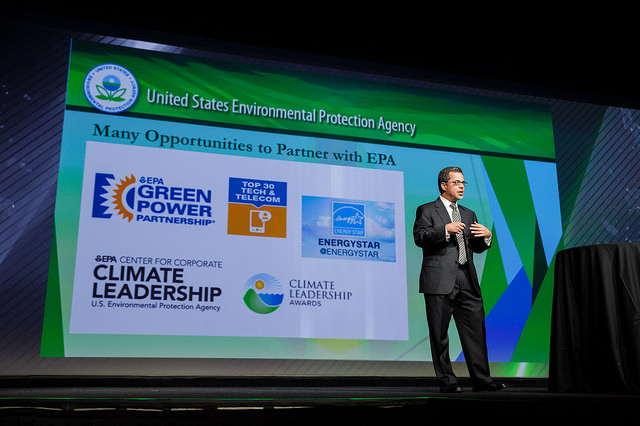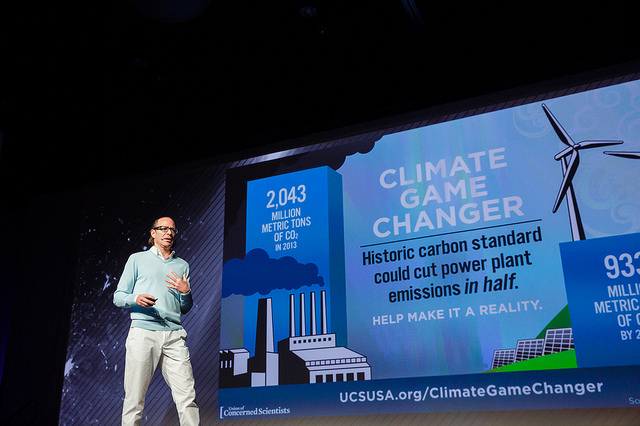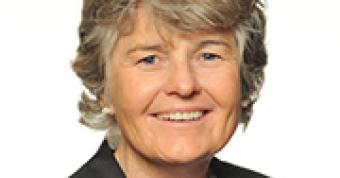Where the FCC meets the EPA: Greening the USA
- Cut Carbon Pollution in America;
- Prepare the United States for the Impacts of Climate Change; and
- Lead International Efforts to Combat Global Climate Change and Prepare for its Impact.
The EPA plays a huge role on the regulatory front in achieving these important goals. EPA’s Proposed Clean Power Plan, presented by Deputy Counsel General Shenkman will reduce carbon pollution from existing power plants by 2030 by approximately 30 percent from 2005 levels. This will cut hundreds of thousands of tons of harmful particle pollution, sulfur dioxide and nitrogen oxides and lead to health and climate benefits
worth an estimated $55 billion to $93 billion by 2030.
So why was the Deputy General Counsel addressing over 700 of the top executives in the global telecommunications sector at our conference?
Here’s a clue: at our 2014 Perspectives conference, another US government official, Jonathan Chambers, chief of the FCC's office of strategic planning and policy, presented another keynote, taking the audience on a memorable journey back into the heydays of the 1990s and the legislative work that was going on amid fierce competition. Companies were investing in infrastructure left and right, and the nation was confronted with challenges associated with the transformation of massive networks from fixed services into the Broadband and IP services era.
Mr. Chambers spoke with great intensity about the Rural Broadband Experiment, whereby the FCC asked the public to submit general, creative proposals for getting broadband services to underserved areas, with a primary intent to encourage nontraditional entities to participate. Over 1,000 proposals were received, and many are now being implemented.
The government spends nearly $10 billion a year through various programs on getting broadband to underserved areas – not a huge amount of money, but important money considering the upside of enabling connectivity and opportunity which lead to education and economic productivity.
At the same conference, we talked about a very creative way for not only the government, but service providers to bring vital IP services to all, funded with cost savings associated with – energy and carbon reduction.
Today, we find ourselves at the intersection of opportunity for not only the EPA to mandate and support the reduction of carbon pollution and its impact on the environment through the President’s Climate Action plan (saving billions of dollars in taxpayer’s money in the next fifteen years) and the opportunity for the FCC and telecommunications community to work together to:

- Reduce energy costs 70%
- Reduce water usage 70%
- Reduce real estate requirements 85%
- Reduce CO2 emissions 40%
How? By transforming the PSTN to IP, collectively and collaboratively.
While the FCC is spending $10B a year bringing broadband to underserved areas, it is providing $4B in subsidies to service providers to keep the old fixed line networks running. Service providers are spending about $1.3 billion of that on infrastructure, and frankly not moving quickly enough to transform networks so they can support everybody’s common goal – broadband access for all which means healthy revenue and profits for the telecom industry and a more productive, safe and healthy society for Americans.
Our vision? Create an initiative working with elected and non-elected officials in the US government to implement environmental programs affecting over 30,000 “Central Offices” and Data Centers in the US, which can with a few solid moves reduce their costs so dramatically that they have the capital to invest in broadband networks and communications applications that will make life better for hundreds of millions of people.
The opportunity is both short and long term. It’s right in front of us. By joining forces between the EPA and FCC, with better technology and business models provided by the private sector, our generation has a once in a lifetime opportunity to make money – and a difference – and that may be the best balance of all.
Here’s a short video on how this works.




